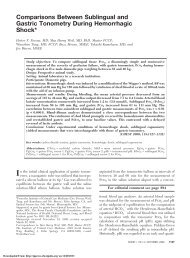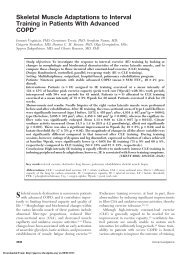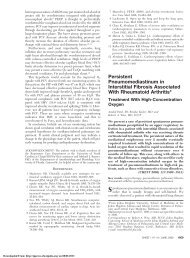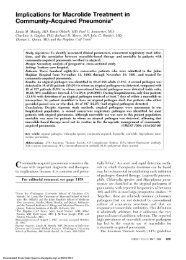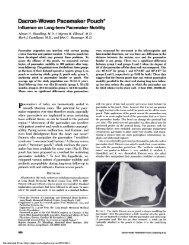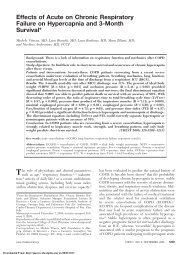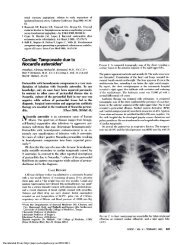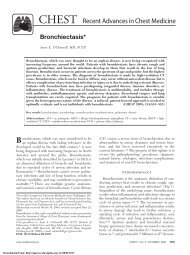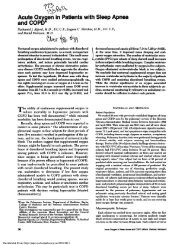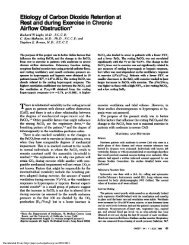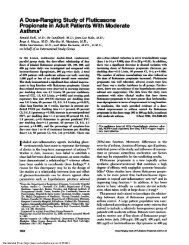Allergic bronchopulmonary aspergillosis - CHEST Publications ...
Allergic bronchopulmonary aspergillosis - CHEST Publications ...
Allergic bronchopulmonary aspergillosis - CHEST Publications ...
Create successful ePaper yourself
Turn your PDF publications into a flip-book with our unique Google optimized e-Paper software.
Table 5—Criteria Used for the Diagnosis of ABPA<br />
Rosenberg-Patterson criteria 6,9<br />
Major criteria (mnemonic ARTEPICS)<br />
A Asthma<br />
R Roentgenographic fleeting pulmonary opacities<br />
T Skin test positive for Aspergillus (type I reaction,<br />
immediate cutaneous hyperreactivity)<br />
E Eosinophilia<br />
P Precipitating antibodies (IgG) in serum<br />
I IgE in serum elevated ( 1,000 IU/mL)<br />
C Central bronchiectasis<br />
S Serums A fumigatus-specific IgG and IgE (more than<br />
twice the value of pooled serum samples from patients with<br />
asthma who have Aspergillus hypersensitivity)<br />
Minor criteria<br />
Presence of Aspergillus in sputum<br />
Expectoration of brownish black mucus plugs<br />
Delayed skin reaction to Aspergillus antigen (type III<br />
reaction)<br />
The presence of six of eight major criteria makes the diagnosis<br />
almost certain; the disease is further classified as ABPA-S or<br />
ABPA-CB on the absence or presence of central<br />
bronchiectasis, respectively<br />
Minimal diagnostic criteria for ABPA 32<br />
Minimal ABPA-CB<br />
Asthma<br />
Immediate cutaneous hyperreactivity to Aspergillus antigens<br />
Central bronchiectasis<br />
Elevated IgE<br />
Raised A fumigatus-specific IgG and IgE<br />
Minimal ABPA-S<br />
Asthma<br />
Immediate cutaneous hyperreactivity to Aspergillus antigens<br />
Transient pulmonary infiltrates on chest radiograph<br />
Elevated IgE<br />
Raised A fumigatus-specific IgG and IgE<br />
specific IgE and IgG levels can help in confirming<br />
the diagnosis of ABPA because values of IgG/IgE<br />
more than twice the pooled serum samples from<br />
patients with asthma are raised only in ABPA. 113,132<br />
We currently use a cutoff value of 1,000 IU/mL for<br />
the diagnosis of ABPA. 22,23 While investigating a<br />
patient with asthma, we first perform an Aspergillus<br />
skin test. Once it is positive, the total serum IgE<br />
levels are done. 131 If the value is 1,000 IU/mL, we<br />
perform the other tests (Fig 5). If the value is<br />
between 500 and 1,000 IU/mL, the next step is analysis<br />
of A fumigatus-specific IgE and IgG antibodies. If the<br />
levels are raised, the patient is followed up every 6 weeks<br />
with total IgE levels. If the absolute value rises 1,000<br />
IU/mL or there is a rising trend with clinical deterioration,<br />
the treatment is started. If the value is between 500 and<br />
1,000 IU/mL and IgE and IgG specific to A fumigatus are<br />
not raised, the patient is followed up with a yearly total<br />
IgE levels (Fig 5).<br />
Natural History<br />
The natural history of ABPA is not well characterized.<br />
9,128,133–136 An early diagnosis and initiation of<br />
systemic corticosteroids are essential to prevent irreversible<br />
damage. 137 The natural course of ABPA can<br />
be best understood if we recognize the two important<br />
classification schemes (Tables 6 and 7) of ABPA:<br />
(1) classification of ABPA into five stages as described<br />
by Patterson et al 8 , and (2) classification of<br />
ABPA into ABPA-S (seropositive ABPA) and ABPA-CB<br />
(ABPA with central bronchiectasis) described by<br />
Greenberger et al. 12<br />
Staging of ABPA: ABPA has been classified into<br />
five stages, but a patient does not necessarily<br />
progress from one stage to the other sequentially<br />
(Table 6). Patients in stage I or III (depending on<br />
whether or not the disorder has been previously<br />
diagnosed) are generally symptomatic with radiographic<br />
infiltrates, raised IgE levels, and elevated A<br />
fumigatus-specific IgG/IgE. 23 With glucocorticoid<br />
therapy, there is clearing of radiographic opacities<br />
with a 35 to 50% decline in IgE levels by 6 weeks<br />
that defines remission or stage II. The aim of<br />
glucocorticoid therapy is not normalization of total<br />
IgE levels because the immunologic process goes in<br />
remission with just 35 to 50% decline in IgE levels,<br />
and in many patients the IgE levels do not come to<br />
down to normal values. The test needs to be often<br />
repeated during therapy to determine the lowest<br />
level for an individual patient that serves as the<br />
baseline for that particular patient. Treatment is<br />
continued for 6 to 9 months, and if there are no<br />
exacerbations over the next 3 months after stopping<br />
therapy, we label it as “complete remission.” Patients<br />
in complete remission are followed up by serial IgE<br />
levels every 6 months for the first year and then<br />
annually. Even in patients with complete remission,<br />
the IgE levels decline to normal in only a minority of<br />
patients, 128,133 and the aim of glucocorticoid therapy<br />
is not achievement of normal IgE levels. 79 A complete<br />
remission does not imply a permanent remission<br />
because exacerbations can occur several years<br />
after remission. 135 Almost 25 to 50% of the patients<br />
have relapse/exacerbation of the disease, defined by<br />
doubling of the baseline IgE levels (stage III). 8,9,22<br />
Patients in stage IV require oral glucocorticoids for<br />
control of asthma (glucocorticoid-dependent asthma)<br />
or ABPA (glucocorticoid-dependent ABPA). 10,22 Patients<br />
in stage V are those with widespread bronchiectasis<br />
and varying degrees of pulmonary dysfunction.<br />
We define patients in stage V if they have<br />
hypercapnic respiratory failure (Pao 2 60 mm Hg<br />
and Paco 2 45 mm Hg) and/or cor pulmonale.<br />
Even in stage V ABPA, the disease can be clinically<br />
as well as immunologically active requiring longterm<br />
glucocorticoid therapy. 136,138<br />
812 Global Medicine<br />
Downloaded From: http://jupcvss.chestpubs.org/ on 08/01/2013



